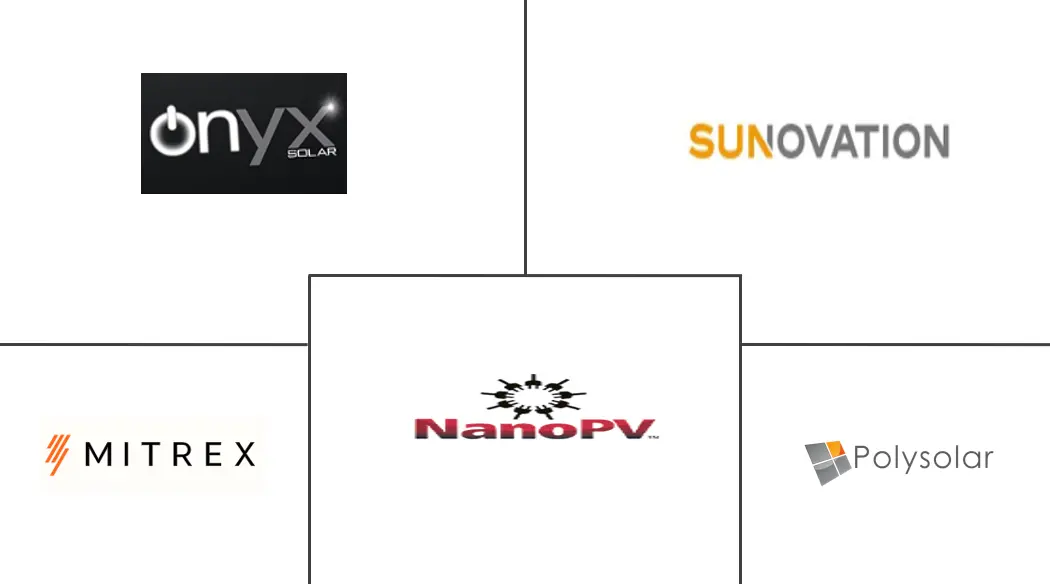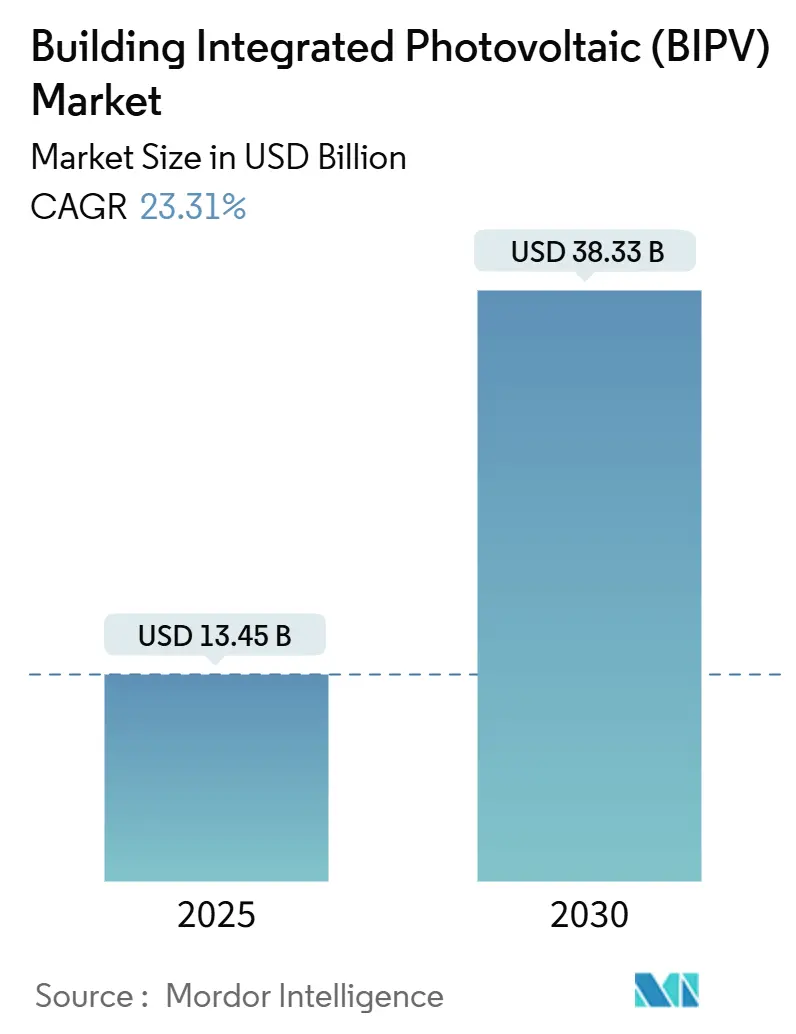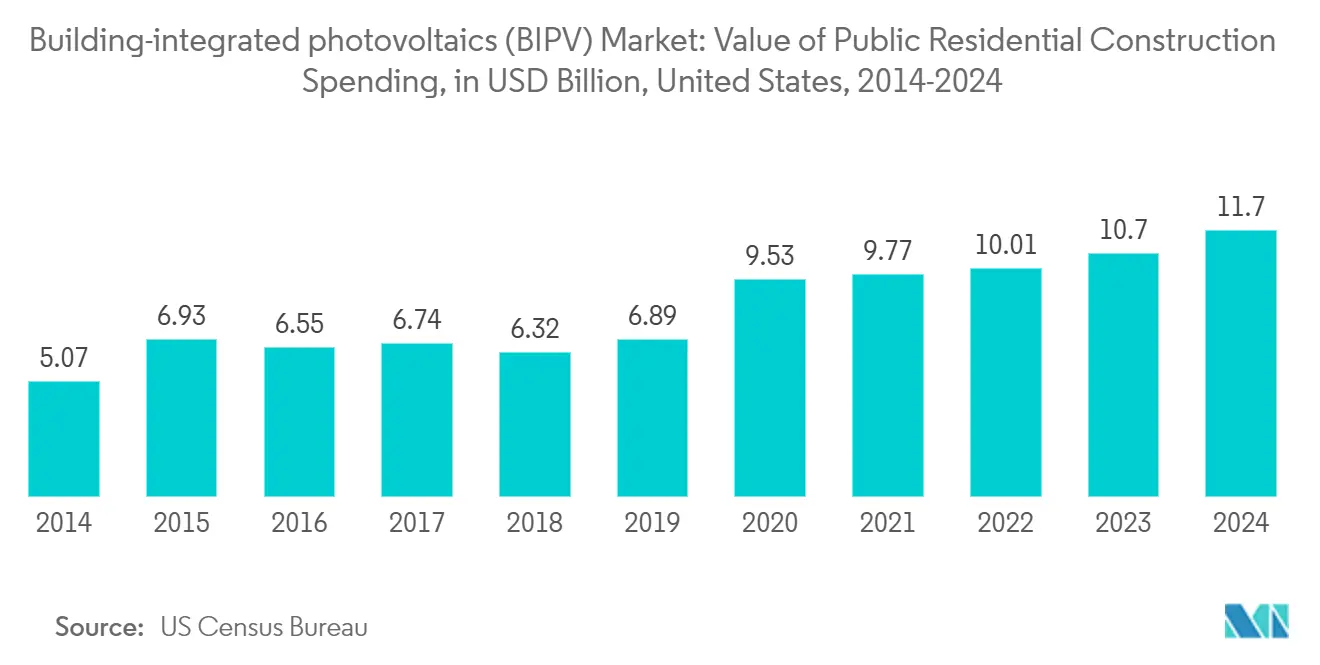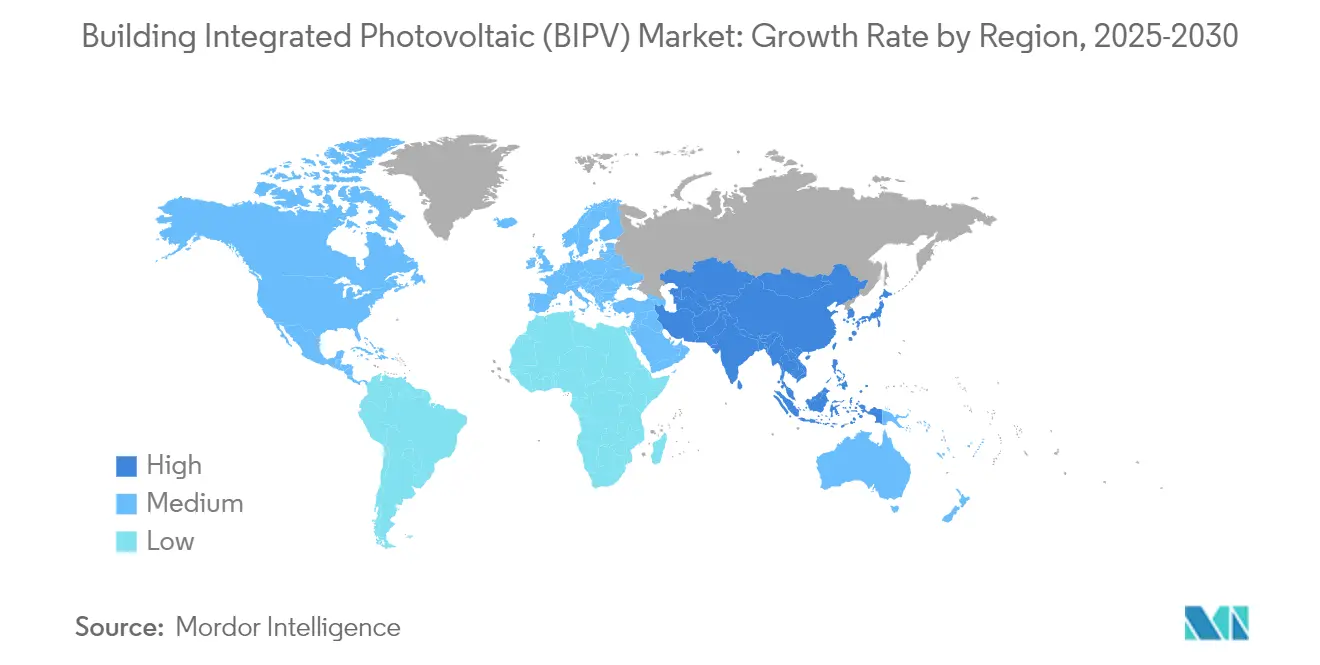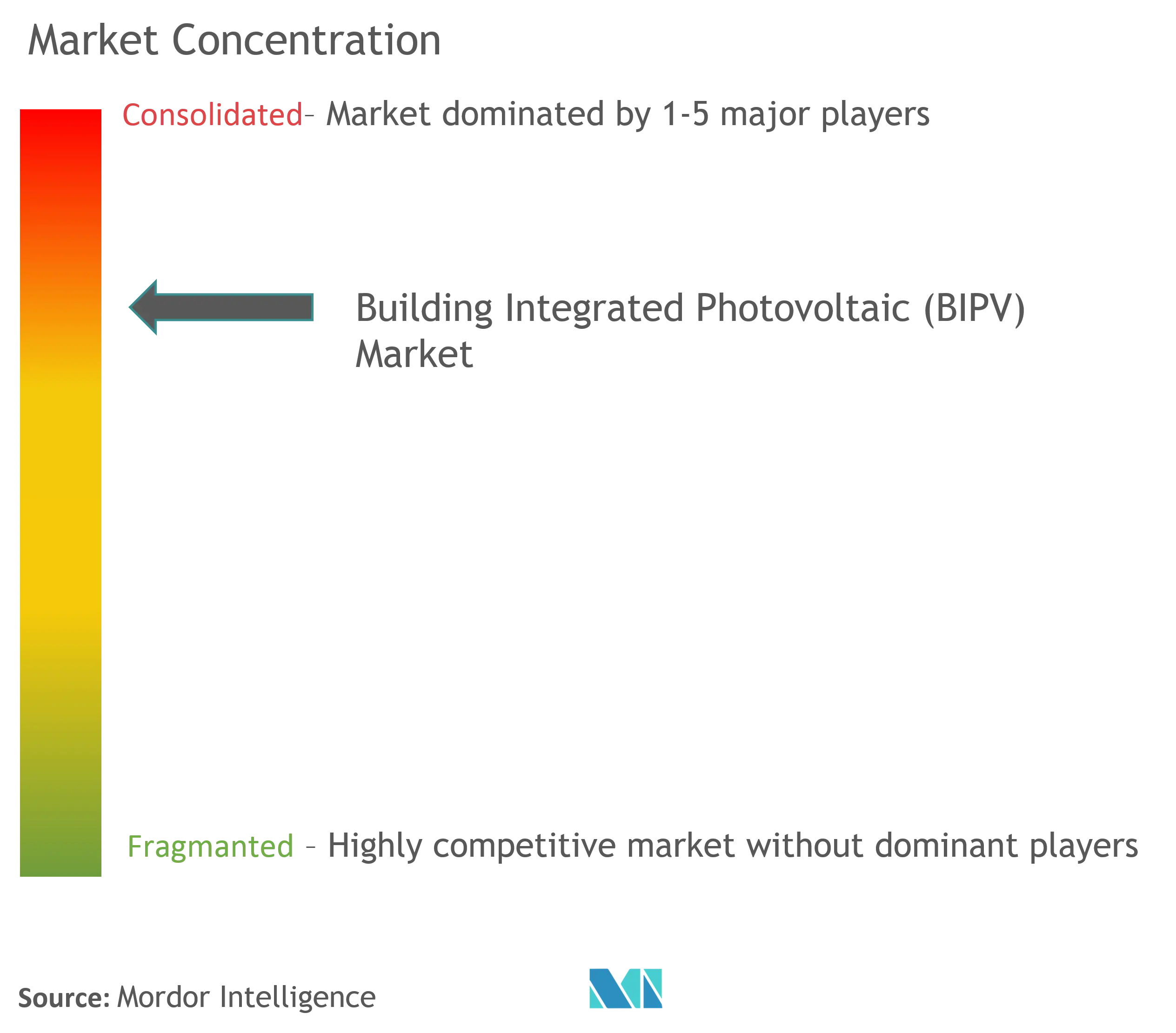Building Integrated Photovoltaic (BIPV) Market Analysis
The Building Integrated Photovoltaic Market size is estimated at USD 13.45 billion in 2025, and is expected to reach USD 38.33 billion by 2030, at a CAGR of 23.31% during the forecast period (2025-2030).
- Over the medium period, factors such as high-rise multi-story buildings and supportive government initiatives are expected to drive the market during the forecast period.
- On the other hand, the high installation cost compared to rooftop PV systems will likely negatively impact the market’s growth.
- Nevertheless, the rapid urbanization and development of smart cities are enormous opportunities for BIPV systems. The governments of almost all countries are moving toward renewables-oriented energy policies to reach their carbon neutrality goals.
- Asia-Pacific is expected to dominate the building-integrated photovoltaics market due to declining solar technology costs in the region.
Building Integrated Photovoltaic (BIPV) Market Trends
Residential Segment is Expected to Have a Significant Market Growth
- As residential construction surges, so does the integration of Building-Integrated Photovoltaics (BIPV). With each new home, opportunities arise to embed solar technologies into roofs, facades, and windows. This trend is further fueled by sustainability regulations, energy efficiency aspirations, and declining costs of solar technologies.
- Globally, housing demand is on the rise, driven by urbanization, population growth, and a burgeoning middle class. These factors outstrip housing supply, pushing prices up and creating affordability challenges.
- Housing plays a pivotal role in the U.S. economy, encompassing new constructions, existing home sales, and home improvements, all of which bolster the GDP. Data from the US Census Bureau highlights a significant uptick in public residential construction spending in the U.S. between 2019 and 2024. Public sector expenditures on residential projects jumped from nearly USD 6.89 billion in 2019 to an impressive USD 11.7 billion in 2024. With projections indicating a continued rise in the value of new residential constructions, these trends bode well for the BIPV market.
- Furthermore, Companies are actively embedding PV technology into homes. A notable example: In February 2025, a Canadian firm launched semi-transparent and opaque solar PV railing systems.
- Amidst global energy crises and a push for a decarbonized electricity sector, decentralized electricity generation is gaining traction. As a result, the residential sector is poised to lead the charge in BIPV technology deployment in the coming years.
Asia-Pacific is Expected to Dominate the Market
- Asia-Pacific has adeptly adopted solar PV technologies across various industries, achieving notable cost-effectiveness. The region's solar technology has matured, with prices consistently declining.
- China, India, Japan, and ASEAN nations have showcased their prowess in solar power generation, pioneering innovative technologies like BIPVs and rooftop installations. Notably, China's production in the PV industry surpasses 50% of the global scale, solidifying its position as a frontrunner.
- BIPVs are pivotal in the construction sector, championing sustainability by harnessing clean energy, curbing carbon emissions, and enhancing energy efficiency. As green building certifications gain momentum, PV-integrated buildings are set to emerge as paragons of sustainable development, steering us towards a greener future.
- China is ambitiously targeting its climate objectives: peaking carbon dioxide emissions before 2030 and achieving carbon neutrality by 2060. As per the Action Plan for Carbon Dioxide Peaking Before 2030, introduced by China's State Council in October 2021, there's a pronounced push for renewable energy in buildings, emphasizing solar panel integration.
- In its latest energy White Papers, the Chinese government underscores its commitment to elevating energy-saving building standards. Supporting this vision, over 31 provinces have rolled out policies championing green building construction.
- China is also at the forefront of developing new BIPV products. For example, in February 2025, UtmoLight's gigawatt-scale perovskite solar module facility in Wuxi commenced production, focusing on ultra-large perovskite modules and BIPV products, with an anticipated annual output of 1.8 million modules.
- Japan is not to be outdone in the BIPV arena. In August 2023, Panasonic Holdings Corporation unveiled a prototype of building-integrated Perovskite photovoltaics glass, initiating a year-long technical test at the "Future Co-Creation FINECOURT III" model house in Fujisawa Sustainable Smart Town, Kanagawa Prefecture.
- As Japan approaches its 2030 renewable energy commitments and decarbonization targets, it's exploring avenues to bolster its renewable energy stance. With solar power facing land development challenges, BIPV emerges as a swift solution for expanding generation capacity. Both national and regional Japanese authorities are rolling out policies to promote BIPV system installations in homes and businesses.
- Given these advancements, Asia-Pacific is poised to lead the market in the foreseeable future.
Building Integrated Photovoltaic (BIPV) Industry Overview
The building-integrated photovoltaics market is semi-consolidated. The key players in this market (not in particular order) include Onyx Solar Group LLC, SUNOVATION GmbH, Mitrex INC., NanoPV Solar Inc., and Polysolar Limited.
Building Integrated Photovoltaic (BIPV) Market Leaders
-
Onyx Solar Group LLC
-
SUNOVATION GmbH
-
Mitrex INC.
-
NanoPV Solar Inc.
-
Polysolar Limited
- *Disclaimer: Major Players sorted in no particular order
Building Integrated Photovoltaic (BIPV) Market News
- February 2025: Microquanta launched the world's largest building-integrated photovoltaic (BIPV) project, harnessing perovskite panels, at the University Student Entrepreneurship Center in Shanxi. The installation, perched atop the translucent roof of the center in Shenchi County, Shanxi Province, boasts a capacity of 17.92 kWp. The double-glass perovskite modules, each measuring 1,200 mm x 1,000 mm, are engineered for a light transmittance of approximately 40%.
- February 2025: Avancis unveiled its newest module series for building-integrated photovoltaics (BIPV), signaling a shift from traditional thin-film technology. The newly launched Skala Matrix range harnesses crystalline solar technology, boasting superior output compared to the Skala Prime panels, which utilize CIGS technology. However, the Skala Prime panels continue to be offered in the lineup.
- October 2024: Trinasolar Evergreen, the BIPV division of Trina Solar, unveiled four innovative BIPV products tailored for public, industrial, and infrastructure applications. The newly introduced lineup features solar tiles designed for public building rooftops, solar walls for industrial facades, PV noise barriers aimed at highway soundproofing, and colored PV glass suited for architectural installations. Each product is powered by Trina’s advanced tunnel oxide passivated contact (TOPCon) solar cell technology, with select models boasting an efficiency of up to 21.9%.
Building Integrated Photovoltaic (BIPV) Industry Segmentation
Building-integrated photovoltaics (BIPVs) are solar power-producing products or systems that are effortlessly integrated into the building envelope and parts of building apparatuses such as façades, roofs, or windows. A BIPV system serves a dual purpose and is an integral component of the building skin that concurrently converts solar energy into electrical energy.
The building-integrated photovoltaics market is segmented by type, end-user, and geography. By type, the market is segmented into thin-film PV and crystalline PV. By end-user, the market is segmented into residential and commercial & industrial. The report also covers the market size and forecasts for the building integrated photovoltaics market across major regions, such as Asia-Pacific, North America, Europe, South America, the Middle East, and Africa.
For each segment, the market sizing and forecasts have been done based on revenue (USD).
| Type | Thin-film PV | ||
| Crystalline PV | |||
| End User | Residential | ||
| Commercial & Industrial | |||
| Geography | North America | United States | |
| Canada | |||
| Rest of North America | |||
| Europe | Germany | ||
| France | |||
| United Kingdom | |||
| Turkey | |||
| Spain | |||
| NORDIC | |||
| Russia | |||
| Rest of Europe | |||
| Asia-Pacific | China | ||
| India | |||
| Japan | |||
| South Korea | |||
| Malaysia | |||
| Thailand | |||
| Indonesia | |||
| Vietnam | |||
| Rest of Asia-Pacific | |||
| South America | Brazil | ||
| Argentina | |||
| Colombia | |||
| Rest of South America | |||
| Middle East and Africa | Saudi Arabia | ||
| United Arab Emirates | |||
| South Africa | |||
| Nigeria | |||
| Qatar | |||
| Egypt | |||
| Rest of Middle East and Africa | |||
Building Integrated Photovoltaic (BIPV) Market Research Faqs
How big is the Building Integrated Photovoltaic Market?
The Building Integrated Photovoltaic Market size is expected to reach USD 13.45 billion in 2025 and grow at a CAGR of 23.31% to reach USD 38.33 billion by 2030.
What is the current Building Integrated Photovoltaic Market size?
In 2025, the Building Integrated Photovoltaic Market size is expected to reach USD 13.45 billion.
Who are the key players in Building Integrated Photovoltaic Market?
Onyx Solar Group LLC, SUNOVATION GmbH, Mitrex INC., NanoPV Solar Inc. and Polysolar Limited are the major companies operating in the Building Integrated Photovoltaic Market.
Which is the fastest growing region in Building Integrated Photovoltaic Market?
Asia Pacific is estimated to grow at the highest CAGR over the forecast period (2025-2030).
Which region has the biggest share in Building Integrated Photovoltaic Market?
In 2025, the Asia Pacific accounts for the largest market share in Building Integrated Photovoltaic Market.
What years does this Building Integrated Photovoltaic Market cover, and what was the market size in 2024?
In 2024, the Building Integrated Photovoltaic Market size was estimated at USD 10.31 billion. The report covers the Building Integrated Photovoltaic Market historical market size for years: 2019, 2020, 2021, 2022, 2023 and 2024. The report also forecasts the Building Integrated Photovoltaic Market size for years: 2025, 2026, 2027, 2028, 2029 and 2030.
Our Best Selling Reports
Building Integrated Photovoltaic (BIPV) Industry Report
The global building-integrated photovoltaics (BIPV) market is experiencing significant growth, driven by the increasing adoption of renewable energy sources and the integration of photovoltaic systems into building materials such as roofs, skylights, and facades. Leading market segments include crystalline silicon and thin film technologies, with crystalline silicon recognized for its high energy conversion efficiency and suitability for integration into various building surfaces without heavy investments. The use of thin film technology is also rising, especially in applications where weight constraints are a concern.
The demand for BIPV is robust across residential, commercial, and industrial sectors, with industrial applications leading due to their high energy requirements and ongoing efforts to reduce reliance on non-renewable energy sources. The market is further supported by technological innovations and government incentives aimed at reducing greenhouse gas emissions and promoting energy security.
Overall, the BIPV market size is set to continue its growth trajectory, fueled by advancements in photovoltaic technology, increasing environmental consciousness, and the strategic initiatives of leading BIPV companies. For detailed statistics on the BIPV market share, size, and revenue growth rate, refer to industry reports by Mordor Intelligence™, which include market forecast outlooks and historical overviews available as free report PDF downloads.
The industry analysis reveals that the market outlook is positive, with industry trends indicating a steady increase in market value. Market data shows that the market segmentation is diverse, catering to various end users and geographical regions. Industry research highlights the importance of market leaders in driving market growth and shaping the industry outlook.
Market predictions suggest that the industry size will expand significantly, supported by industry information and market forecast data. Industry statistics underscore the importance of market review and market overview in understanding the market dynamics. The report example provided in the report PDF offers a comprehensive view of the market, including market predictions and industry sales.
Research companies play a crucial role in providing industry research and market review, which are essential for understanding market trends and making informed decisions. The market forecast indicates that the industry outlook remains optimistic, with continuous advancements in technology and increasing adoption of BIPV solutions. Industry reports and industry statistics provide valuable insights into market growth and market segmentation, highlighting the potential for significant industry sales and market value expansion.

